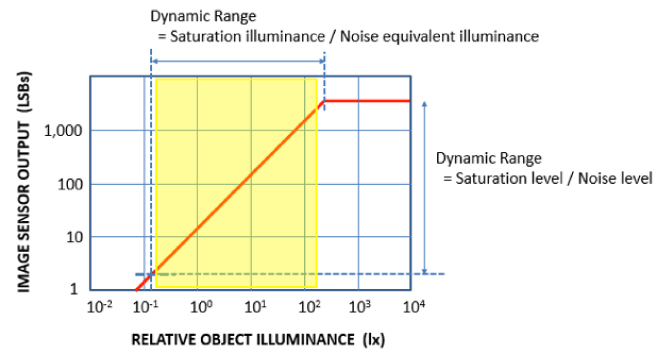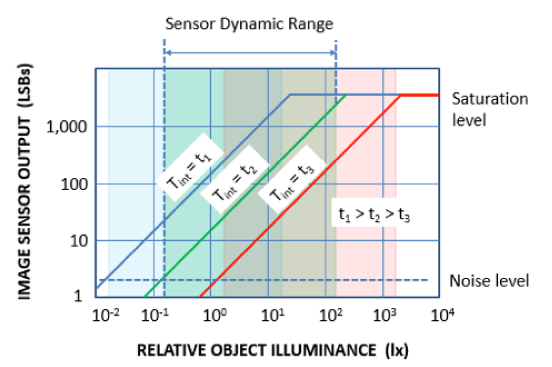Technology:
High Dynamic Range Image Sensors
Dynamic range (DR) is defined as the ratio of the highest detectable illumination level to the lowest detectable illumination level. DR extension towards low light end is usually discussed as ‘sensitivity improvement’. High sensitivity and high DR (HDR) are in a trade-off relationship in general but we need to achieve both. So, how to tackle this issue?
Before discussing HDR approaches, let’s review a definition of DR and the “auto exposure” (AE) technique first.
With a charge integrating mode image sensor, like the CCD image sensor and the CMOS image sensor, DR can be defined as DR = Saturation level/ Noise level As the output should be proportional to the sensor exposure value (; exposure = illuminance exposure time), DR can also be defined as DR = Saturation illuminance / Noise equivalent illuminance This situation is shown in Fig. 1. The DR of the conventional image sensors is 60 ~ 70 dB.

The auto exposure (AE) is a function to adjust the exposure time of the image sensor and/or the aperture (F stop) of the imaging lens so that right signal levels (not too dark, not too bright) from the image sensor can be obtained. In Fig. 2, a situation where the sensor integration time is adjusted to capture an image with right exposure levels is shown. For example, with the integration time of t2, the image sensor captures an image of which relative object illuminance levels range from ~10-1 to ~102 within the sensor’s intrinsic dynamic range. Note that the AE employs just image sensor’s intrinsic dynamic range, while the camera dynamic range is expanded by changing the exposure time of the image sensor and/or the aperture (F stop) of the imaging lens.

The HDR operation is to widening the illuminance range within a reproduced image by combining two (or more) conversion curves. Suppose the image sensor can output two image data sets, one with a high response characteristic and the other with low response characteristic as shown in Fig. 3 (a). The two conversion characteristics can be realized by several approaches. For example, a low response can be obtained by shortening the sensor integration time, or a dual conversion gain pixel can be used. Both high light portions of the scene with the low response and low-light portion with high-sensitivity can be reproduced by processing two image data sets. In Fig. 3 (b), an example of signal processing where the two response curves are added to generate a resulting image is shown. There should be cleverer way in combining two response curves, depending on how the image sensor generates the two or more response curves. Brillnics’ approach to obtain high dynamic range image is referred to as H3 DR View technology.

HDR Approaches
Several approaches to obtain HDR images were proposed, such as a logarithmic response pixel, a linear-logarithmic response pixel, a dual photodiode (PD) pixel, a multiple exposure HDR scheme and a single exposure HDR scheme, etc. Since Brillnics currently adopts the multiple exposure HDR scheme and the single exposure HDR scheme, these two schemes are described below.
